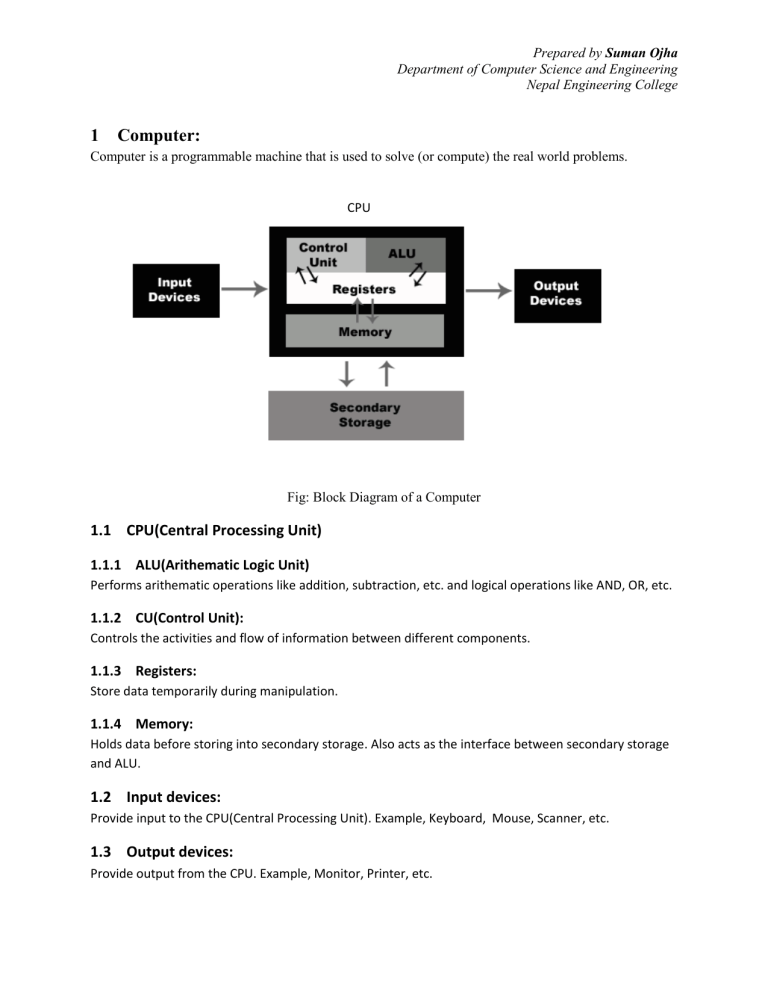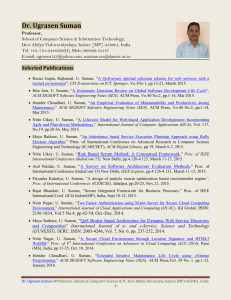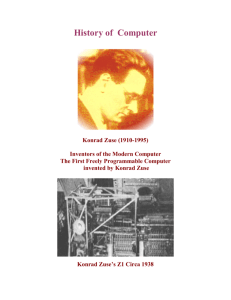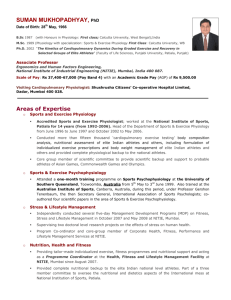1 Computer - Suman Ojha

Prepared by Suman Ojha
Department of Computer Science and Engineering
Nepal Engineering College
1 Computer:
Computer is a programmable machine that is used to solve (or compute) the real world problems.
CPU
Fig: Block Diagram of a Computer
1.1
CPU(Central Processing Unit)
1.1.1
ALU(Arithematic Logic Unit)
Performs arithematic operations like addition, subtraction, etc. and logical operations like AND, OR, etc.
1.1.2
CU(Control Unit):
Controls the activities and flow of information between different components.
1.1.3
Registers:
Store data temporarily during manipulation.
1.1.4
Memory:
Holds data before storing into secondary storage. Also acts as the interface between secondary storage and ALU.
1.2
Input devices:
Provide input to the CPU(Central Processing Unit). Example, Keyboard, Mouse, Scanner, etc.
1.3
Output devices:
Provide output from the CPU. Example, Monitor, Printer, etc.
Prepared by Suman Ojha
Department of Computer Science and Engineering
Nepal Engineering College
1.4
Secondary storage:
Used for permanent storage of data. Example, Hard disk.
2 History of Computing and Computers:
2.1
The word "computer" was first used:
The word "computer" was first recorded as being used in 1613 and was originally used to describe a person who performed calculations or computations. The definition of a computer remained the same until the end of the 19th century when it began referring to a machine that performed calculations.
2.2
First mechanical computer or automatic computing engine concept:
In 1822, Charles Babbage purposed and began developing the Difference Engine , considered to be the first automatic computing engine that was capable of computing several sets of numbers and making a hard copies of the results. Later, in 1837 Charles Babbage proposed the first general mechanical computer, the Analytical Engine . The Analytical Engine contained an
Arithmetic Logic Unit (ALU), basic flow control, and integrated memory and is the first generalpurpose computer concept.
2.3
First programmable computer:
The Z1 , originally created by Germany's Konrad Zuse in his parents living room in 1936 to 1938 is considered to be the first electro-mechanical binary programmable (modern) computer and really the first functional computer.
2.4
The first electric programmable computer:
The Colossus was the first electric programmable computer and was developed by Tommy
Flowers and first demonstrated in December 1943. The Colossus was created to help the British code breakers read encrypted German messages.
2.5
The first digital computer:
Short for Atanasoff-Berry Computer , the ABC started being developed by Professor John
Vincent Atanasoff and graduate student Cliff Berry in 1937 and continued to be developed until
1942 at the Iowa State College (now Iowa State University). The ABC was an electrical computer that used ‘vacuum tubes’ for digital computation including binary math and Boolean logic and had no CPU. The ENIAC was invented by J. Presper Eckert and John Mauchly at the
University of Pennsylvania and began construction in 1943 and was not completed until 1946. It occupied about 1,800 square feet and used about 18,000 vacuum tubes, weighing almost 50 tons.
Although the Judge ruled that the ABC computer was the first digital computer, many still consider the ENIAC to be the first digital computer because it was fully functional.
Prepared by Suman Ojha
Department of Computer Science and Engineering
Nepal Engineering College
2.6
The first stored program computer:
The early British computer known as the EDSAC is considered to be the first stored program electronic computer. The computer performed its first calculation on May 6, 1949 and was the computer that ran the first graphical computer game, nicknamed "Baby".
2.7
First commercial computer:
In 1942, Konrad Zuse begin working on the Z4 , which later became the first commercial computer after being sold to Eduard Stiefel a mathematician of the Swiss Federal Institute of
Technology Zurich on July 12, 1950.
2.8
The first PC (IBM compatible) computer:
IBM introduced its first personal computer called the IBM PC in 1981. The computer was code named and still sometimes referred to as the Acorn and had a 8088 processor, 16 KB of memory, which was expandable to 256 and utilizing MS-DOS.
3 History of Programming:
3.1
1200 - 1940: The Birth of Modern Computing and Programming Ideas
In order for there to be "Programming Languages", we first must have something to program.
The following section outlines the events in history which lead to the development of computers and the languages that run on them.
3.2
1941 - 1950: The Concepts Become Reality
The ideas and thoughts of the past 1900 years come into form as the first computing languages are developed.
3.3
1951 - 1970: Programming As We Know It Begins
As the importance of computers begins to grow rapidly, so does the power of the programming languages that are developed for them.
3.4
1971 - 1990: Languages Are Everywhere
The basis for computer operating systems is born, creating an explosion of programming languages that will make the computer the focal point of business and personal activities.
Prepared by Suman Ojha
Department of Computer Science and Engineering
Nepal Engineering College
3.5
1991 - 2001: The Arrival of the Internet Languages
By the mid 90's, the Internet had become part of our society. With the start of the new millennium, the Internet is as common as the television, and with it comes new languages designed specifically for its use.
4 Generations of Computers:
4.1
First Generation (1945-1955)
Use of vacuum tubes
Big & Clumsy
High Electricity Consumption
Programming in Mechanical Language
Larger AC were needed
Lot of electricity failure occured
4.2
Second Generation (1955-1965)
Transistors were used
Core Memory was developed
Faster than First Generation computers
First Operating System was developed
Programming was in Machine Language & Aseembly Language
Magnetic tapes & discs were used
Computers became smaller in size than the First Generation computers
Computers consumed less heat & consumed less electricity
4.3
Third Generation (1965-1970)
Integrated circuits developed
Power consumption was low
SSI & MSI Technology was used
High level languages were used
4.4
Fourth Generation (1970-1990)
LSI & VLSI Technology used
Development of Portable Computers
RAID Technology of data storage
Used in virtual reality, multimedia, simulation
Computers started in use for Data Communication
Prepared by Suman Ojha
Department of Computer Science and Engineering
Nepal Engineering College
Different types of memories with very high accessing speed & storage capacity
4.5
Fifth Generation (1990- Present)
Used in parallel processing
Used superconductors
Used in speech recognition
Used in intelligent robots
Used in artificial intelligence
5 Types of Computers:
Fig. Types of Digital Computers
5.1
Super Computers:
They are the best in terms of processing capacity and also the most expensive ones. These computers can process billions of instructions per second. Normally, they will be used for applications which require intensive numerical computations such as stock analysis, weather forecasting etc. Other uses of supercomputers are scientific simulations, (animated) graphics, fluid dynamic calculations, nuclear energy research, electronic design, and analysis of geological data (e.g. in petrochemical prospecting).
Perhaps the best known super computer manufacturer is Cray Research. Some of the "traditional" companies which produce super computers are Cray, IBM and Hewlett-Packard. As of July 2009, the IBM
Roadrunner, located at Los Alamos National Laboratory, is the fastest super computer in the world.
5.2
Mainframe Computers:
Mainframe computers can also process data at very high speeds i.e., hundreds of million instructions per second and they are also quite expensive. Normally, they are used in banking, airlines and railways etc for their applications.
Prepared by Suman Ojha
Department of Computer Science and Engineering
Nepal Engineering College
5.3
Mini Computers:
Mini computers are lower to mainframe computers in terms of speed and storage capacity. They are also less expensive than mainframe computers. Some of the features of mainframes will not be available in mini computers. Hence, their performance also will be less than that of mainframes.
5.4
Micro Computers:
The invention of microprocessor (single chip CPU) gave birth to the much cheaper micro computers.
They are further classified into-
Desktop Computers
Laptop Computers
Handheld Computers(PDAs)
References:
[1] http://www.computerhope.com/issues/ch000984.htm
[2] http://www2.lv.psu.edu/ojj/courses/ist-240/reports/spring2001/fa-cb-bc-kf/historyindex.html
[3] http://library.thinkquest.org/08aug/01795/Website/generations_of_computer.html












